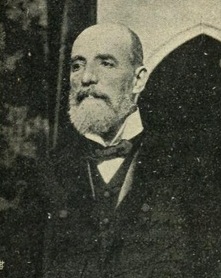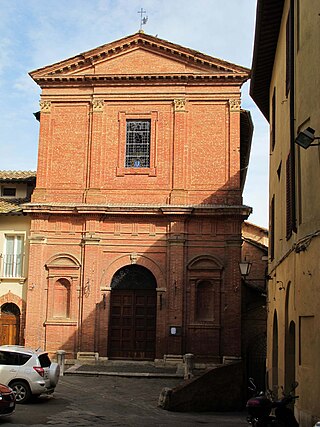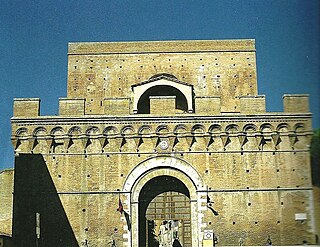
The Palazzo Pubblico is a palace in Siena, Tuscany, central Italy. Construction began in 1297 to serve as the seat of the Republic of Siena's government, which consisted of the Podestà and Council of Nine, the elected officials who performed executive functions.

Cristoforo Roncalli was an Italian mannerist painter. He was one of the three painters known as Pomarancio or Il Pomarancio.
Pier Angelo Basili was an Italian painter of the 16th century Renaissance period. He was born in Gubbio after 1550, and trained with Felice Damiani and Cristoforo Roncalli. He painted in fresco for the cloister of Sant Tibaldo in Gubbio and an oil canvas of Christ preaching for the church of San Marziale. During 1601–1602, he painted frescoes alongside Federico Brunorino in the presbytery of the church of Santa Croce in Gubbio.

Alessandro Casolani (1552–1606) was an Italian painter of the late-Renaissance period, active mainly in Siena.
Ilario Casolano was an Italian painter of the Baroque period.

Cesare Maccari was an Italian painter and sculptor, most famous for his 1888 painting Cicerone denuncia Catilina.

The Pinacoteca Nazionale is a national museum in Siena, Tuscany, Italy. Inaugurated in 1932, it houses especially late medieval and Renaissance paintings from Italian artists. It is housed in the Brigidi and Buonsignori palaces in the city's center: the former, built in the 14th century, it is traditionally identified as the Pannocchieschi family's residence. The Palazzo Bichi-Buonsignori, although built in the 15th century, has a 19th-century neo-medieval façade based on the city's Palazzo Pubblico.
Bartolomeo Neroni, also known as Il Riccio or Riccio Sanese (c.1505-1571) was an Italian painter, sculptor, architect and engineer of the Sienese School. He was born and died in Siena.

Cristoforo Greppi was an Italian painter of the Mannerist period, active in Rome.

San Giovannino della Staffa, also known as San Giovannino in Pantaneto is a Renaissance style, Roman Catholic church located on Piazetta Virgilio Grassi, in the Contrada del Leocorno, in the city of Siena, region of Tuscany, Italy.

The Palazzo Palmieri, or Palazzo Nuti, is a Mannerist style urban palace, located on Via del Moro #48 in the present contrada of Civetta, Terzo di Camollia of the city of Siena, region of Tuscany, Italy.

Santi Quirico e Giulitta, also called San Quirico in Castelvecchio is a Renaissance style, Roman Catholic parish church located in Pian de Mantellini in the Terzo de Citta of Siena, region of Tuscany, Italy.

San Niccolò al Carmine, also called Santa Maria del Carmine is a Renaissance style, Roman Catholic church and monastery located in Pian dei Mantellini #30, near the corner of Via della Diana in the Terzo de Citta of Siena, region of Tuscany, Italy. The church now serves as the Oratory for the Contrada of Pantera. Across the street from the belltower is the Palazzo Celsi Pollini. North along Pian dei Mantellini, toward the Arco delle Due Porte, and on the same side of the street are a number of palaces built around what was once the Monastery of the Derelict Women: in order they are the Neoclassical Palazzo Incontri, the Palazzo Ravissa and the Palazzo Segardi.

Santa Maria in Portico a Fontegiusta is a Renaissance style, Roman Catholic church located on via di Fontegiusta, off Via Camollia near its intersection with Via Paparoni, in the terzo of Camollia, in Siena, region of Tuscany, Italy.

The Palazzo Celsi Pollini, once also called the Palazzo del Vescovo, is a Renaissance style urban palace in Siena, Italy. It is located on Pian dei Mantellini #39-41, at the corner with Via San Quirico. A 19th-century source refers to the house as Casa Campioni. The main facade faces the campanile of San Niccolò del Carmine.

The Porta dei Pìspini or Gate of the Water-spout is one of the portals in the medieval walls of Siena, region of Tuscany, Italy. It is located on the east side of town, in the contrada del Nicchio in the terzo of San Martino, where Via Pìspini meets Via Aretina. The gate took its name from a nearby fountain; the nearby Fonte de' Pispina, however, was built in 1534–1538.

Vincenzo Rustici was an Italian painter active in Siena. He was known for his religious compositions as well as his vedute showing public celebrations in Siena.

The Palazzo Venturi Gallerani is an 18th-century palace on via delle Cerchia #6, near the Pinacoteca Nazionale in Siena, Tuscany, Italy. The palace is presently occupied by private residences.

The Oratory of the Compagnia di San Bernardino is a place of worship in the Piazza San Francesco in Siena. Elevated to minor basilica status in 1925 by Pope Pius XI, it adjoins rooms housing the diocesan museum. It is notable for its frescoes from various 16th- and 17th-century Sienese painters like Sodoma and Domenico Beccafumi. The oratory is almost adjacent to the Basilica of San Francesco, Siena.


















